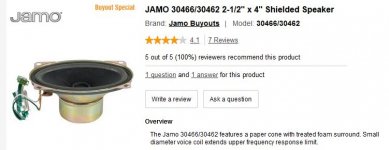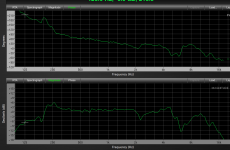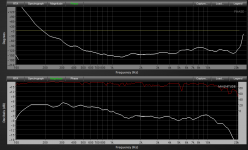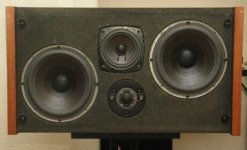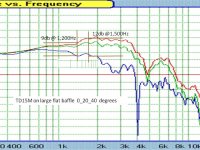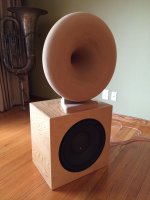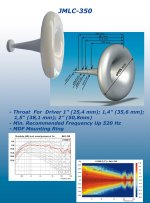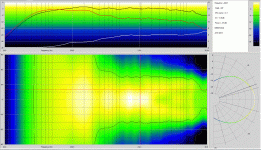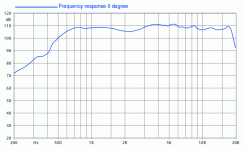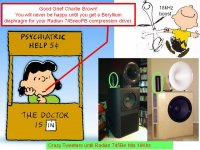Happy to disagree with you
Derek - of course I don't agree with you, if you know me then that should have gone without saying.
I don't know you at all, never met you or spoken with you....
Our "talking at each other" audio banter hardly qualifies as getting to know someone....
We are poles apart in audio and I am very content with that....
Cheers
Derek.
Earl, all valid questions, hopefully Toaster wont mind if I try and answer them.
It goes without saying that all subjective development is guided by objective measurements to some degree, I doubt anyone uses one method to the total exclusion of the other.
If you had to pick one or the other, which would you choose...?
In a commercial world would you present a loudspeaker design with to the board or if it was your own money, deliver the speakers to your dealers without ever having listened to them.....Could a totally deaf person with great technical skills design a great loudspeaker without any subjective input ( his own or a listening panels) ???
Another way of looking at it....Would your typical music / movie lover rather have a great sounding speaker that did measure very well, or a loudspeaker that had great measurements but did not sound good?
The bottom line is how it sounds is more important than how it measures!
The ironic twist in the tail is that in order to be able to design the best sounding loudspeakers on needs to be guided by objective tests and measurements....
But one should never discount a design that sounds superior to, but does not t measure as well, as an inferior sounding design....
You are then being misguided by the wrong measurements... Not guided by the correct measurements!
Hope this helps
Cheers
Derek.
I quickly reading through what you said, I agree with this. IMV you can have a speaker system that measures well but pleases less. Anybody making a living from the gear will always make a biased view regardless of how honest they feel they are . It is a human bias along with many others that make us all different, and absolute truth is hard to find and verify other than perhaps by a mathematical logician to a fellow logician.
We all know ' instinctively' what we are impressed with, like and continue to like without becoming dulled. If we can keep on going back and testing and come back to the same impression then great. But even we move on with time. So nothing in the end is stable. If we get a speaker soiund that we can literally live with this is going to be awinner. The Quad ELS 57 achieved this for many decades for many.
I had some Behringer speakers that almost derailed awell known designer with his best unit in a back to back trial. I happened by chance to have bought the same model. I decided to strip out the drivers and refit with my own selection of drivers.
Last edited:
I'm sure there is life in the BMR (bending mode radiator) sort of speaker. Which essentially uses a large flat diaphragm. The Manger Zerobox 103 is a typical example:
Very unusual and accurate sound, but not easy to get right IMO. Dispersion is an issue at high frequency.
As for measurement, we do rely far too much on simple frequency response and harmonic distortion on axis. You can do a lot more with dispersion and white noise testing. White noise testing is an old radio frequency technique whereby you inject a sine wave and measure the white noise produced right across the band.
The phase response is also useful. Every kink in it corresponds to energy storage. You can see that the Vifa XT25 ring radiator (here modelled with a 6" paper bass) does a very good job of keeping phase straight at high frequency compared to a typical Visaton SC10N soft dome. It'll sound different. And you can see why when you measure the right thing.
An externally hosted image should be here but it was not working when we last tested it.
Very unusual and accurate sound, but not easy to get right IMO. Dispersion is an issue at high frequency.
As for measurement, we do rely far too much on simple frequency response and harmonic distortion on axis. You can do a lot more with dispersion and white noise testing. White noise testing is an old radio frequency technique whereby you inject a sine wave and measure the white noise produced right across the band.
The phase response is also useful. Every kink in it corresponds to energy storage. You can see that the Vifa XT25 ring radiator (here modelled with a 6" paper bass) does a very good job of keeping phase straight at high frequency compared to a typical Visaton SC10N soft dome. It'll sound different. And you can see why when you measure the right thing.
Attachments
Yes, any driver with a diameter larger than the wavelengths reproduced will have "dispersion issues" in the high frequencies, the reason for small tweeters. A single Manger driver does exhibit near flat phase on axis though.I'm sure there is life in the BMR (bending mode radiator) sort of speaker. Which essentially uses a large flat diaphragm. The Manger Zerobox 103 is a typical example:
Very unusual and accurate sound, but not easy to get right IMO. Dispersion is an issue at high frequency.
The phase response is also useful. Every kink in it corresponds to energy storage. You can see that the Vifa XT25 ring radiator (here modelled with a 6" paper bass) does a very good job of keeping phase straight at high frequency compared to a typical Visaton SC10N soft dome. It'll sound different. And you can see why when you measure the right thing.
The cheap drivers used in this project have much flatter phase response than the Vifa you showed:
http://www.diyaudio.com/forums/multi-way/236037-dirty-dozen-line-array.html#post4071085
After Derek (Overkill Audio) mentioned his listening tests of horizontal arrays of 9 BMR drivers wide, realized that although the adverse effects of that arrangement on dispersion are well known, I had not actually measured it. Yesterday completed vertical dispersion tests on the "full range" line arrays in the link above, they illustrate the problems quite well.
Art
I think we have just invented the CHARS transducer! 
CHEAP ARRAY OF RADIO SPEAKERS!
It's an interesting notion. We know that light cones, small voicecoils and foamed surrounds make for interesting fulllrange drivers. Though rigid sort of surrounds work well too. Add the Oval shape and resonances will be more smeared at least.
In fact this is quite like the 100V line column arrays we used to use for public address in my College Common Room. It sounded good and projected well. Not convinced about the linear phase response though. I want to see a graph!
CHEAP ARRAY OF RADIO SPEAKERS!
It's an interesting notion. We know that light cones, small voicecoils and foamed surrounds make for interesting fulllrange drivers. Though rigid sort of surrounds work well too. Add the Oval shape and resonances will be more smeared at least.
In fact this is quite like the 100V line column arrays we used to use for public address in my College Common Room. It sounded good and projected well. Not convinced about the linear phase response though. I want to see a graph!
Attachments
CHARS, I like it.I think we have just invented the CHARS transducer!
CHEAP ARRAY OF RADIO SPEAKERS!
Not convinced about the linear phase response though. I want to see a graph!
Well, there are plenty of graphs already in the Dirty Dozen thread, but here is the frequency and phase response both raw, and with EQ. The phase was flatter in the low end prior to making the cabinet a bass reflex.
Art
Attachments
I like to get some sort of conclusion out of any idea. Otherwise I lie awake at night worrying about stuff. 
Seems to me your oval radio speaker might work very well as a midrange. I seem to recall the legendary (and flawed by terrible low impedance) Gale 401A used a foamed Peerless midrange unit not dissimilar.
Then have an XT25 as a top end. Bass is another issue. They all seem to work well enough.
Which leaves us with all the filters and all the options of bass loading. And arrays.
Seems to me your oval radio speaker might work very well as a midrange. I seem to recall the legendary (and flawed by terrible low impedance) Gale 401A used a foamed Peerless midrange unit not dissimilar.
Then have an XT25 as a top end. Bass is another issue. They all seem to work well enough.
Which leaves us with all the filters and all the options of bass loading. And arrays.
Attachments
Newbie Speaker Build: Part 1
Probably the biggest advantage I have in attempting my first “from scratch” speaker build is that my brother, who’ll actually be building the enclosures, is a brilliant carpenter. I do have a basic design concept, and if can ask enough of the right questions here I think I may finish with happy results.
Woofer & Enclosure section: I want to choose among the Great Plains 416-8/16B, 515-8/16C and 515-8/16LF. The 416-8B spec sheet speaks of its smooth response. And the curve on p. 2 also seems to show an impressively flat midbass and lower midrange response. http://www.greatplainsaudio.com/downloads/416-8B%20Spec%20Sheet.pdf (though no curves included for http://www.greatplainsaudio.com/downloads/515_C.pdf and http://www.greatplainsaudio.com/downloads/515_LF.pdf )
Presumably, this performance may be due, at least in part, to the Alnico magnet.
But in your experience-using a sealed cabinet-please estimate which of these
woofers would likely have a.) the best bass, midbass and lower midrange response b.) “tightest” most articulate bass c.) “cleanest” low distortion sound d.) able to produce its full bandwidth down to ~35Hz @ 85db at 8 to 10 watts in a ~ 14 x 7 x 13 room.
Now, please repeat your estimated ratings of these three woofers against the same performance goals using a ported cabinet.
Like the GPA 416B and 515C, does anyone know if the 515LF can be ordered with an Alnico magnet?
What, if any, are the advantages of Alnico in one of the above woofers for achieving my performance goals?
In order to produce cabinet and/or port diameter dimensions for given T/S parameters,
please provide the link to a recommended online calculator or some cost-effective software.
Is a triangular or polygonal woofer enclosure the best way to prevent internal standing waves?
Also, please provide the link to a good primer(s) on preventing diffraction problems in speaker design. Thank you.
My current direct radiators (GPA-416 alnico) sound vastly superior. I am just thrilled to have such beautiful sound in my listening room at last, after all these years of effort. To have it be the result of DIY is even better! Gary Dahl
Probably the biggest advantage I have in attempting my first “from scratch” speaker build is that my brother, who’ll actually be building the enclosures, is a brilliant carpenter. I do have a basic design concept, and if can ask enough of the right questions here I think I may finish with happy results.
Woofer & Enclosure section: I want to choose among the Great Plains 416-8/16B, 515-8/16C and 515-8/16LF. The 416-8B spec sheet speaks of its smooth response. And the curve on p. 2 also seems to show an impressively flat midbass and lower midrange response. http://www.greatplainsaudio.com/downloads/416-8B%20Spec%20Sheet.pdf (though no curves included for http://www.greatplainsaudio.com/downloads/515_C.pdf and http://www.greatplainsaudio.com/downloads/515_LF.pdf )
Presumably, this performance may be due, at least in part, to the Alnico magnet.
But in your experience-using a sealed cabinet-please estimate which of these
woofers would likely have a.) the best bass, midbass and lower midrange response b.) “tightest” most articulate bass c.) “cleanest” low distortion sound d.) able to produce its full bandwidth down to ~35Hz @ 85db at 8 to 10 watts in a ~ 14 x 7 x 13 room.
Now, please repeat your estimated ratings of these three woofers against the same performance goals using a ported cabinet.
Like the GPA 416B and 515C, does anyone know if the 515LF can be ordered with an Alnico magnet?
What, if any, are the advantages of Alnico in one of the above woofers for achieving my performance goals?
In order to produce cabinet and/or port diameter dimensions for given T/S parameters,
please provide the link to a recommended online calculator or some cost-effective software.
Is a triangular or polygonal woofer enclosure the best way to prevent internal standing waves?
Also, please provide the link to a good primer(s) on preventing diffraction problems in speaker design. Thank you.
oltos, Your questions are very diverse.
Q?: Do you want to invest significant money and time to "educate yourself" on crossover design, speaker measurement, and cabinet construction to create your own unique speaker? OR learn as you copy a proven design? OR copy the Heart of a proven design with cost reductions around the edges? Heart: GPA416-8 alnico in sealed box + LeCleach 350-425 horn + 1.4" modern compression driver.
Q?: 2 vs 3 vs 4 way??
g3dahl is a golden ear professional conductor who can accurately voice a speaker for "the best total sound" If you carefully copy g3dahl's final 4-way construction and crossover posts you can be confident of great success without wasting money and time. Purchase more expensive speakers, but save on trial-and-error crossover components plus measurement tools.
You may decide to experiment at controlling cost like: selecting an aluminum dome Radian 745NEO instead of the Be dome; a low cost super tweeter instead of the RAAL Lazy ribbon; two modest cost counter-force side-mounted 18" woofers instead of TD15H + two PRs.
Q?: Do you want to invest significant money and time to "educate yourself" on crossover design, speaker measurement, and cabinet construction to create your own unique speaker? OR learn as you copy a proven design? OR copy the Heart of a proven design with cost reductions around the edges? Heart: GPA416-8 alnico in sealed box + LeCleach 350-425 horn + 1.4" modern compression driver.
Q?: 2 vs 3 vs 4 way??
g3dahl is a golden ear professional conductor who can accurately voice a speaker for "the best total sound" If you carefully copy g3dahl's final 4-way construction and crossover posts you can be confident of great success without wasting money and time. Purchase more expensive speakers, but save on trial-and-error crossover components plus measurement tools.
You may decide to experiment at controlling cost like: selecting an aluminum dome Radian 745NEO instead of the Be dome; a low cost super tweeter instead of the RAAL Lazy ribbon; two modest cost counter-force side-mounted 18" woofers instead of TD15H + two PRs.
g3dahl is a golden ear professional conductor who can accurately voice a speaker for "the best total sound" If you carefully copy g3dahl's final 4-way construction and crossover posts you can be confident of great success without wasting money and time. Purchase more expensive speakers, but save on trial-and-error crossover components plus measurement tools. LineSource
I will agree, voicing a speaker to extract its max potential is time consuming and tedious work. Has the schematic for Gary's crossover been posted here? If so, I must have missed it and would appreciate it if you could point me to it.
Last edited:
oltos, Your questions are very diverse.
Q?: Do you want to invest significant money and time to "educate yourself" on crossover design, speaker measurement, and cabinet construction to create your own unique speaker? OR learn as you copy a proven design? OR copy the Heart of a proven design with cost reductions around the edges? Heart: GPA416-8 alnico in sealed box + LeCleach 350-425 horn + 1.4" modern compression driver.
Q?: 2 vs 3 vs 4 way??
g3dahl is a golden ear professional conductor who can accurately voice a speaker for "the best total sound" If you carefully copy g3dahl's final 4-way construction and crossover posts you can be confident of great success without wasting money and time. Purchase more expensive speakers, but save on trial-and-error crossover components plus measurement tools.
You may decide to experiment at controlling cost like: selecting an aluminum dome Radian 745NEO instead of the Be dome; a low cost super tweeter instead of the RAAL Lazy ribbon; two modest cost counter-force side-mounted 18" woofers instead of TD15H + two PRs.
LineSource actually beat me to responding to this thread and did a better, and perhaps more even-handed responce to the post, than I probably would have. Good Job!
I might add something to this, since Gary's speakers are under discussion. Several Members of the "Sound DIY" Club are going to return again to listen to Gary's speakers and system. Gary has made some significant changes to his speakers as well as having built a Dedicated Music Server designed by one of our Members. As the speaker is still undergoing development it may be wise to wait and see how everything pans out before investing fairly substancial money into a design that is still underway.
Best Regards,
TerryO
~~~~~~~~~~~~~~~~~snip~~~~~~~~~~~~~~~~
Gary has made some significant changes to his speakers as well as having built a Dedicated Music Server designed by one of our Members.
~~~~~~~~~~~~~~~~~snip~~~~~~~~~~~~~~~~~
I was just told that the Music Server mentioned above was actually named "The Silent Server" by the designer, Renan Jeffereis.
It is an excellent server that actually is totally silent in operation!
Best Regards,
TerryO
oltos,
Little boxes, little boxes, little boxes on the hillside..... and they're all made out of ticky-tacky glue, but none sound just the same.
Altec 416-8B common box tunings:
--sealed 3 cuft F3~68Hz
--ported 5 cuft F3~37Hz
--MLTL 12 cuft F3~27Hz
I agree with most folks here that a well stuffed sealed tuning sounds best.
I like the idea of two 18" counter-force side-mounted woofers below the Altec.
You can run Jeff Bagby's "Baffle Edge Diffraction Simulator" with your room dimensions to estimate bass frequency room gain, floor bounce, and cabinet edge(radius) diffraction effects. g3dahl used LARGE MDF edge rounds. There are a few other free room/speaker placement analysis programs. Distance-from-walls has a large effect on bass. Height-above-floor ground bounce is easy to observe.
==========
The Other Guy... another "best of show" speaker...
Dr. Geddes's NS15 speaker polar plots are the best I have ever seen. Geddes uses a 1" compression driver on a 18" diameter OS waveguide crossed ~900Hz to a wide bandwdith 15" sealed midbass. I'm a believer, and have collected TD15M midbass + Faital HF10AK compression and plan to find a JMLC350 horn with 1" throat. No Lazy Ribbons generating nasty polars hanging around here.
If your Brother's wood shop includes CNC tools which can manufacture stacked-MDF JMLC 350 horns, he could sell small hobby production lots. Winter is coming. Great stocking stuffer.
Little boxes, little boxes, little boxes on the hillside..... and they're all made out of ticky-tacky glue, but none sound just the same.
Altec 416-8B common box tunings:
--sealed 3 cuft F3~68Hz
--ported 5 cuft F3~37Hz
--MLTL 12 cuft F3~27Hz
I agree with most folks here that a well stuffed sealed tuning sounds best.
I like the idea of two 18" counter-force side-mounted woofers below the Altec.
You can run Jeff Bagby's "Baffle Edge Diffraction Simulator" with your room dimensions to estimate bass frequency room gain, floor bounce, and cabinet edge(radius) diffraction effects. g3dahl used LARGE MDF edge rounds. There are a few other free room/speaker placement analysis programs. Distance-from-walls has a large effect on bass. Height-above-floor ground bounce is easy to observe.
==========
The Other Guy... another "best of show" speaker...
Dr. Geddes's NS15 speaker polar plots are the best I have ever seen. Geddes uses a 1" compression driver on a 18" diameter OS waveguide crossed ~900Hz to a wide bandwdith 15" sealed midbass. I'm a believer, and have collected TD15M midbass + Faital HF10AK compression and plan to find a JMLC350 horn with 1" throat. No Lazy Ribbons generating nasty polars hanging around here.
If your Brother's wood shop includes CNC tools which can manufacture stacked-MDF JMLC 350 horns, he could sell small hobby production lots. Winter is coming. Great stocking stuffer.
Attachments
A few thoughts:
1. I haven't posted a schematic of my current crossover. If one tried to duplicate the circuit with different autoformers the response wouldn't be the same anyway. I would hesitate to encourage someone to build a system like this if they won't be able to make measurements. I am quite pleased with the way it sounds now, but there is room for improvement.
2. The system is presently a 2-way plus subwoofers (no ribbons). Passive equalization is used to extend the highs of the Radian 745. Imaging is much better this way, and it sounds more natural (less "hi-fi") to me.
3. The GPA 416-8B sounds great in a ~3cf sealed enclosure, and its well-controlled LF rolloff makes it easy to integrate a subwoofer (or two) of one's choice.
4. I used MDF corners with a 4-inch radius. They were designed to mate with panels of 3/4" thickness. You can find them here (part number 4QL-3496-MDF).
5. Based on my experiences thus far, I would have to say that I don't care for the sound of aluminum diaphragms with classical music. No matter how flat the frequency response is made, I hear a layer of metallic haze that interferes with the upper harmonics of orchestral strings and woodwinds. For some reason this doesn't bother me when listening to non-classical genres, but it should be no surprise that I can't live with a speaker system that steers me away from orchestral music.
Gary Dahl
1. I haven't posted a schematic of my current crossover. If one tried to duplicate the circuit with different autoformers the response wouldn't be the same anyway. I would hesitate to encourage someone to build a system like this if they won't be able to make measurements. I am quite pleased with the way it sounds now, but there is room for improvement.
2. The system is presently a 2-way plus subwoofers (no ribbons). Passive equalization is used to extend the highs of the Radian 745. Imaging is much better this way, and it sounds more natural (less "hi-fi") to me.
3. The GPA 416-8B sounds great in a ~3cf sealed enclosure, and its well-controlled LF rolloff makes it easy to integrate a subwoofer (or two) of one's choice.
4. I used MDF corners with a 4-inch radius. They were designed to mate with panels of 3/4" thickness. You can find them here (part number 4QL-3496-MDF).
5. Based on my experiences thus far, I would have to say that I don't care for the sound of aluminum diaphragms with classical music. No matter how flat the frequency response is made, I hear a layer of metallic haze that interferes with the upper harmonics of orchestral strings and woodwinds. For some reason this doesn't bother me when listening to non-classical genres, but it should be no surprise that I can't live with a speaker system that steers me away from orchestral music.
Gary Dahl
2. The system is presently a 2-way plus subwoofers (no ribbons). Passive equalization is used to extend the highs of the Radian 745. Imaging is much better this way, and it sounds more natural (less "hi-fi") to me.
5. Based on my experiences thus far, I would have to say that I don't care for the sound of aluminum diaphragms with classical music.
Gary Dahl
... everybody dance! ... Beryllium lives up to it's (expensive) potential ...
"Plastics" was the promised future in "The Graduate" are plastic diaphragms more musical than aluminum?
Attachments
yes, for example the Ketone Plymer from Faital is very musical. it only extends to around 12K but it's treble is very true. The main problem with no tweeter is a realistic sense of power response
when i tried ribbons and stats with horns for upper treble I always felt it sounded fake. A smaller horn with a 1" driver can be marvelous.
the same in-distinctions i get with using a ribbon or stat for upper treble can also be said for using a direct radiator bass with a horn loaded midrange. If it will fit go fully horn loaded as low as you can - there will be soulful rewards
Horn systems are personal creations built for your room, listening habits, music genre, budget and expectations of reality. your mileage will vary
when i tried ribbons and stats with horns for upper treble I always felt it sounded fake. A smaller horn with a 1" driver can be marvelous.
the same in-distinctions i get with using a ribbon or stat for upper treble can also be said for using a direct radiator bass with a horn loaded midrange. If it will fit go fully horn loaded as low as you can - there will be soulful rewards
Horn systems are personal creations built for your room, listening habits, music genre, budget and expectations of reality. your mileage will vary
An externally hosted image should be here but it was not working when we last tested it.
Not mine but I like it lots.
The thing I really like about Gary's two way is it gives one options. Since the F3 rolloff in sealed is below 80hz, one can go with different sub solutions if one doesn't want to go with the TD15. For example, one could use the multi-sub solution ala Toole/Geddes for spatial smoothing of room modes. Also makes the mains a bit more compact for smaller rooms/WAF.
- Home
- Loudspeakers
- Multi-Way
- Beyond the Ariel

